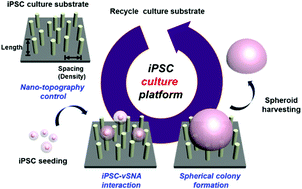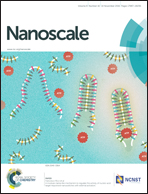Vertical nanocolumn-assisted pluripotent stem cell colony formation with minimal cell-penetration†
Abstract
The biological applications of vertical nanostructures mostly rely on their intracellular accessibility through the cellular membrane by promoting cell-to-nanostructure interactions. Herein, we report a seemingly counter-intuitive approach for the spontaneous formation of mouse induced pluripotent stem cell (iPSC)-derived three-dimensional spherical colonies with unlimited self-renewal and differentiation potential. The comprehensive analyses of iPSCs cultured on vertical silicon nanocolumn arrays (vSNAs) with various nanocolumn geometries show reduced cell-to-substrate adhesion and enhanced cell-to-cell interactions under optimized vSNA conditions, successfully accommodating the spontaneous production of iPSC-derived spherical colonies. Remarkably, these colonies which were only minimally penetrated by and thereby easily harvested from wafer-sized vSNAs display a substantial increase in pluripotency marker expression and successfully differentiate into three germ layers. Our vSNAs capable of large-scale fabrication, efficient for spherical colony formation, and reusable for multiple iPSC culture could serve as a broad-impact culture platform for stem cell research.


 Please wait while we load your content...
Please wait while we load your content...